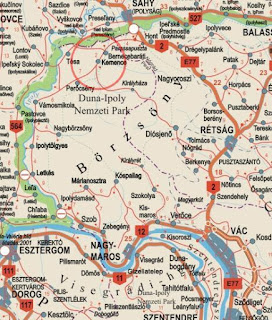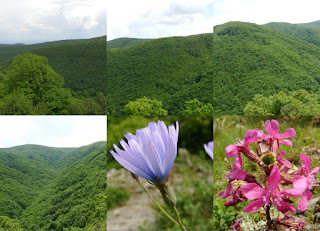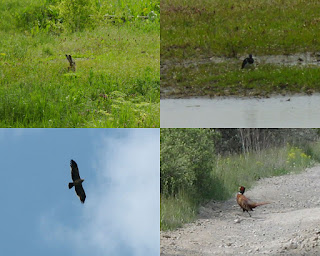
We were at Pentecost for
3 days in reserve Börzsöny Mountains in northern Hungary, about 100 km from Budapest, near the Slovak border. It is of volcanic origin. On a former crater rim are the highest peaks in the Börzsöny, including the Csóványos, which is 938 m with the highest elevation in the mountainous region. The area covers the area of about 400 km. Most of the natural sources for its many well-known area is protected.In the north of Magas-Börzsöny Kemence is the stream that borders the northern part.(The name derives from the Slavic word from Kamenica, which means "stony river bed.") The area can be further divided into two main parts,separated by a valley from each other. The northern part consists mainly of sedimentary rock that was created prior to the volcanic activity. In contrast, the South lava is the predominant substrate.

To the rich wildlife of the area also includes the stock of big game, including deer, wild boar, roe deer and even the mouflon. Often come pheasants, foxes before, hares, badgers, martens, weasels and otters. The birds of prey include the Eastern Imperial Eagle,Saker Falcon of the hawk and the goshawk. The best-known songbirds are the nightingale, the thrush and the lark. In the village there is a
forest Kemence and Museum Railway. This is the only railway line in Hungary, which is operated solely by volunteers work. Technical special feature of this railway is the 600 mm gauge, and a special expansion of the trail. The course is developed so that there is a continuous gradient (which was previously necessary for timber transport). The village inhabitants Kemence i1174, and was in the XVIII. Century, the capital of the garrison county Hont. Kemence is today one of the Pest County, and is one of the tourist center of the area.

Wir waren am Pfingsten 3 Tage lang in Naturschutzgebiet Börzsöny-Gebirge ( deutsch Pilsengebirge ) in Nord Ungarn, ungefährlich 100 km von Budapest, nahe der slowakischen Grenze. Es ist vulkanischen Ursprungs. An einem ehemaligen Kraterrand befinden sich die höchsten Gipfel des Börzsöny, darunter auch der Csóványos, der mit 938 m die höchste Erhebung des Mittelgebirges bildet. Das Gebiet erstreckt sich über etwa 400 km² . Der größte Teil des für seine Vielzahl an natürlichen Quellen bekannten Gebiets steht unter Naturschutz. Im Norden des Magas-Börzsöny bildet der Kemence-Bach die Grenze zum nördlichen Teil. (Der Name leitet sich vom slawischen
Wort kamenica ab, das soviel wie „steiniges Flussbett“ bedeutet. ) Das Gebiet lässt sich weiter in zwei Hauptteile gliedern, die durch ein Tal voneinander getrennt sind. Der nördliche Teil besteht größtenteils aus Sedimentgestein, das bereits vor der vulkanischen Aktivität entstanden ist. Im Süden ist dagegen Lavagestein das
vorherrschende Untergrundmaterial.

Zu der reichen Tierwelt des Gebiets gehört auch der Bestand an Großwild, darunter der Rothirsch, das Wildschwein, das Reh und auch das Mufflon. Häufig kommen Fasane, Füchse, Feldhasen, Dachse, Marder, Wiesel und Fischotter vor. Zu den Raubvögeln gehört der Östliche Kaiseradler, der Sakerfalke, der Sperber und der Habicht.
Die bekanntesten Singvögel sind die Nachtigall, die Amsel und die Lerche.
In Dorf Kemence findet sich ein Wald- und Museumsbahn. Diese Eisenbahnlinie ist die einzige in Ungarn, die ausschliesslich durch Freiwillige Arbeit betrieben ist. Technische besonderheit dieser Eisenbahn ist die 600 mm Spurweite, und eine besondere ausbau der Strecke. Die Strecke ist so ausgebaut, das es eine kontinuierlich Steigung gibt (das war früher für Holzbeförderung nötig). Das
Dorf Kemence i1174 Einwohnern, und war in der XVIII. Jahrhundert das Hauptstadt den Burgkomitat Hont. Kemence gehört heute zu das Komitat Pest, und ist eine der touristischen Zentrums der Gegend.















